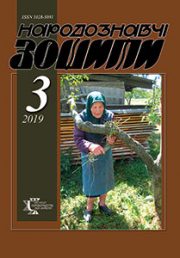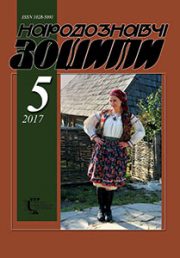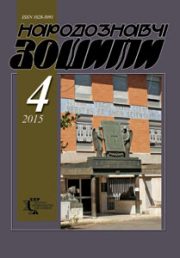The Ethnology Notebooks. 2020. № 1 (151), 207—219
UDK7.071.1(=161.2)(436.1)”18″
DOI https://doi.org/10.15407/nz2020.01.207
THEODOR YAKHYMOVYCH (BASED ON YAROSLAVA MUZYKA’S ARCHIVE)
KUPCHYNSKA Larysa
ORCID ID: https://orcid.org/0000-0001-6461-4819
PhD candidate of Art Studies, Associate Professor,
acting head of the department of scientific research
of works of fine and musical art
of Vasyl Stefanyk National Scientific
Library of Ukraine in Lviv
2, Stefanyk st., 79000, Lviv, Ukraine,
Contacts: e-mail: oklarysa@gmail.com
Abstract. Problem statement. The article is devoted to the actual problem of art studies (art criticism) such as the discovery of little-known pages of creative biography of Ukrainian artists. These include Theodor Yakhymovych (1800—1889) — painter, graphic artist, theater decorator, who having graduated from the Vienna Academy of Fine Arts in 1828 worked in Vienna until the end of his life. The analysis of scientific publications concerning the subject confirmed the need to study Yaroslava Muzyka’s archive, which includes documents prepared by Maria-Sophia Dolnytska. Hidden for objective reasons, today they are significantly expanding information about T. Yakhymovych and defining the purpose of the article: discovering new facts about the life and activity of the artist. The object of the study is the manuscript documents and the photographs of T. Yakhymovych’s works. The subject of the study is the work of T. Yakhymovych in close connection with the artistic environment of 19th century in Vienna. Many facts from T. Yakhymovych’s biography, which have not been covered in the literature, are presented in the article. They are mainly related to the personal life of the artist, give an idea of his character and preferences. Based on the study of 29 works of art by T. Yakhymovych, which are now being introduced for the first time into scientific circulation, the article reveals the subject and genre structure of the artist’s artistic achievements, the compositional, figurative and meaningful solution of particular works, especially landscapes and portraits. Using the methods of comparison and synthesis, it is proved that T. Yakhymovych used the education that he received at the Vienna Academy of Fine Arts, reinterpreted the experience of the leading Austrian masters of the 19th century, interpreted it in accordance with the requirements of the time, and thus contributed to the establishment of new progressive tendencies in the art. The new data on T. Yakhymovych cited in the article clearly show that the Ukrainian artist has enriched the national treasury with his work and also increased the culture of Austria in the first place. Today T. Yakhymovych’s artistic heritage is a significant component of the history of Ukrainian and European art.
Keywords: Theodor Yakhymovych, archive, handwritten documents, photographs of works, Vienna Academy of Fine Arts, experience of Austrian artists, new tendencies in art, author’s approach.
Received 22.01.2020
REFERENCES
We come back briefly again… (1844). Lviv newspaper, 5, 38 [in Polish].
Because Mr. Wyslobocki (1844). Lviv newspaper, 7, 49 [in Polish].
Mr. Wyslobocki already… (1844). Lviv newspaper, 14, 95, 96 [in Polish].
Boloz Antoniewicz, J. (Ed.). (1894). Catalog of the exhibition of Polish art from 1764—1886 with 75 illustrates. Lviv: From the printing house of E. Winiarz [in Polish].
Mycielski, J. (1897). One hundred years of history of painting in Poland 1760—1860: From the occasion of the Retrospective Exhibition of Polish Painting in Lviv 1894. Krakow: In the printing house «Time» [in Polish].
Zarewicz, S. (Ed.). (1925). Catalog of the exhibition of old Lviv masters with 15 tables and indexes. Lviv: Printed in academic fonts in Lviv [in Polish].
Holubets, M. (1925). One hundred years of Galician painting. Old Ukraine: History and Culture Magazine, VII/X, 140—153. Lviv [in Ukrainian].
Holubets, M. (1937). Art. In: History of Ukrainian Culture. Lviv: Publication of Ivan Tiktor [in Ukrainian].
Holubets, M. (1926). One hundred years of Galician painting. In: Galician painting. Lviv: [w. p.] [in Ukrainian].
Kachmar, V. (1967). Forgotten painter (Theodor Yakhymovych). Freedom: Ukrainian daily, 107, 5 [in Ukrainian].
Muzyka, Ya. (1968). Fedir Yakhymovych. Art, 4, 20 [in Ukrainian].
Popovych, V. (1969). Theodor Yakhymovych. Ukrainian Art Digest, 9, 32—42 [in Ukrainian].
Popovych, V. (1969). Theodor Yakhymovych. Philadelphia: Published by U.A.A. in U.S.A., Philadelphia branch [in Ukrainian].
Dolnytskyi, O. (2004). Chronicle of the Dolnytsky family. Documents, Materials, Memories: A Genealogical Study. Lviv: Edition of Ukrainian Catholic University [in Ukrainian].
Kupchynsky, O. (2004). Archive materials of the Association of Independent Ukrainian Artists in Lviv: statute, session protocols, entry applications and other doсuments. Notes of the Shevchenko Scientific Society (Vol. CCXLVIII, pp. 432—486) [in Ukrainian].
Burachynska L. (1987). Mature years (1915—1939). In: Olena Zaliznyak: monograph. Toronto: The New Way [in Ukrainian].
Nimchuk, I. (1926). Our artistic antiquity in Vienna. Ukrainian art, 2, 47—51 [in Ukrainian].
Popovych, V. (1965). The enamel master is Maria Dolnytska. Modernity, 5, 49—65 [in Ukrainian].
Borys Voznytsky Lviv National Art Gallery. Folio Ya. Muzyky (archive) (Box 2, folder XXIV) (Th. Yakhymovych). Dolnytska M. Exhibition of paintings by Ukrainian painter Theodor Yakhymovych in Vienna in 1939 [in Ukrainian].
Borys Voznytsky Lviv National Art Gallery. Folio Ya. Muzyky (archive) (Box 2, folder XLII (letters of M. Dolnytska). Dolnytska M. Letter to Yaroslava Muzyka from February 9, 1938 [in Ukrainian].
Borys Voznytsky Lviv National Art Gallery. Folio Ya. Muzyky (archive) (Box 2, folder XXIV) (Th. Yakhymovych). Muzyka Ya. Fedir Yakhymovych /Theodor (Manuscript) [in Ukrainian].
The Academy of Fine Arts Vienna. University Archive. Act № 28 [in German].
The Academy of Fine Arts Vienna. University Archive. Act № 29 [in German].
Roll, J. & Rozman, K. (2018). Franz Caucig: Italian thoughts. Petersberg: Publishing house of Franz Philipp Rutzen [in German].
Frodl-Schneemann, M. (1984). Johann Peter Krafft 1780—1856: Monograph and list of paintings. Vienna: Herold [in German].
Wagner, W. (1967). The history of the Academy of Fine Arts in Vienna. Vienna: Rosenbaum [in German].
Ovsiychuk, V. (2001). Classicism and Romanticism in the Ukrainian art. Kyiv: Dnipro [in Ukrainian].






